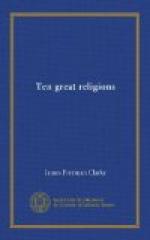The rock-cut temples of the Buddhists are very ancient, and are numerous in India. Mr. Fergusson, who has made a special personal study of these monuments, believes that more than nine hundred still remain, most of them within the Bombay presidency. Of these, many date back two centuries before our era. In form they singularly resemble the earliest Roman Catholic churches. Excavated out of the solid rock, they have a nave and side aisles, terminating in an apse or semi-dome, round which the aisle is carried. One at Karli, built in this manner, is one hundred and twenty-six feet long and forty-five wide, with fifteen richly carved columns on each side, separating the nave from the aisles. The facade of this temple is also richly ornamented, and has a great open window for lighting the interior, beneath an elegant gallery or rood-loft.
The Buddhist rock-cut monasteries in India are also numerous, though long since deserted. Between seven and eight hundred are known to exist, most of them having been excavated between B.C. 200 and A.D. 500. Buddhist monks, then as now, took the same three vows of celibacy, poverty, and obedience, which are taken by the members of all the Catholic orders. In addition to this, all the Buddhist priests are mendicants. They shave their heads, wear a friar’s robe tied round the waist with a rope, and beg from house to house, carrying their wooden bowl in which to receive boiled rice. The old monasteries of India contain chapels and cells for the monks. The largest, however, had accommodation for only thirty or forty; while at the present time a single monastery in Thibet, visited by MM. Huc and Gabet (the lamasery of Kounboum), is occupied by four thousand lamas. The structure of these monasteries shows clearly that the monkish system of the Buddhists is far too ancient to have been copied from the Christians.
Is, then, the reverse true? Did the Catholic Christians derive their monastic institutions, their bells, their rosary, their tonsure, their incense, their mitre and cope, their worship of relics, their custom of confession, etc., from the Buddhists? Such is the opinion of Mr. Prinsep (Thibet, Tartary, and Mongolia, 1852) and of Lassen (Indische Alterthumskunde). But, in reply to this view, Mr. Hardwicke objects that we do not find in history any trace of such an influence. Possibly, therefore, the resemblances may be the result of common human tendencies working out, independently, the same results. If, however, it is necessary to assume that either religion copied from the other, the Buddhists may claim originality, on the ground of antiquity.
But, however this may he, the question returns, Why call Buddhism the Protestantism of the East, when all its external features so much resemble those of the Roman Catholic Church?




